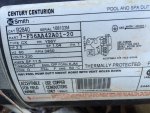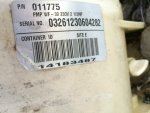Hello Everyone,
New member here, with the recent purchase of a home that came with a pool. Best I can tell, the pool was installed in 2005 or 2006. In full disclosure, I feel a bit overwhelmed as I've never owned a pool before, so I wanted to turn to the experts to get advice and a good understanding of the current setup. I want to make sure that the current equipment makes sense for the size of the pool and what, if any, changes I should consider particularly in the area of energy efficiency. I do not have any specifics on water chemistry on this time (working on getting those), but from what I've seen the water is fairly clear (although I wouldn't call it crystal clear).
Pool Specifics:
Main: 34' x 16' with average depth of 6 feet (roughly)
Step in Area: 6' x 8' with average depth of 2 feet
Spa: 5' x 8' with average depth of 1.5 feet
Equipment Specifics (will attach pictures to this message):
Pump 1: Whisperflo P/N 011775 Single Speed 2.5 HP 230V
Motor: AO Smith 2.5HP 3450RPM 230V 11.5 Amps Serial #168103M Part#7-F56AA42A01-20
Filter: Pentair Triton II Sand Filter Part # 140210
Distance Specifics
The distance from the pool to the pump and filter: From one skimmer it is approximately 90' and from the other is 115'
There is the old school timer box (with the yellow dials) that controls the pump and the polaris. There is no kind of automation or freeze protection on the current equipment.
Thank you in advance for any help or guidance you can provide and apologies if I haven't provided enough information.
Kind Regards,
Valdeselad
New member here, with the recent purchase of a home that came with a pool. Best I can tell, the pool was installed in 2005 or 2006. In full disclosure, I feel a bit overwhelmed as I've never owned a pool before, so I wanted to turn to the experts to get advice and a good understanding of the current setup. I want to make sure that the current equipment makes sense for the size of the pool and what, if any, changes I should consider particularly in the area of energy efficiency. I do not have any specifics on water chemistry on this time (working on getting those), but from what I've seen the water is fairly clear (although I wouldn't call it crystal clear).
Pool Specifics:
Main: 34' x 16' with average depth of 6 feet (roughly)
Step in Area: 6' x 8' with average depth of 2 feet
Spa: 5' x 8' with average depth of 1.5 feet
Equipment Specifics (will attach pictures to this message):
Pump 1: Whisperflo P/N 011775 Single Speed 2.5 HP 230V
Motor: AO Smith 2.5HP 3450RPM 230V 11.5 Amps Serial #168103M Part#7-F56AA42A01-20
Filter: Pentair Triton II Sand Filter Part # 140210
Distance Specifics
The distance from the pool to the pump and filter: From one skimmer it is approximately 90' and from the other is 115'
There is the old school timer box (with the yellow dials) that controls the pump and the polaris. There is no kind of automation or freeze protection on the current equipment.
Thank you in advance for any help or guidance you can provide and apologies if I haven't provided enough information.
Kind Regards,
Valdeselad



